
The week that was
This week my musical efforts have gravitated towards guitar playing and learning the piece I composed. I had hoped to play some more of it for you this time, but it’s a complicated piece to learn, so I’m afraid it’ll take a little longer. The good thing is, I’m enjoying the learning process, which I’ll tell you about instead.
On the compositional side of things, I’ve also finished off the digital version of the score, which I might consider posting once I’ve learnt it and made the necessary follow-up adjustments, and I’ve been looking more at other movements, especially the third, which I’ll tell you about sometime soon.
Practice
A topic I often think about is practice, and because this week I’ve been working relatively hard on learning the piece, I’ve been getting more and more into ideas about practising musical instruments.
This stuff goes deep, so I’ll have to spread this over more than one post, and it will certainly be a theme I’ll come back to in later posts on this blog.
This time I’ll give you a general overview of some of this week’s thoughts on practice, which I’ll expand on in later posts, as well as some incidental odds and ends of interest.
Playful and experimental practice
The aspect of my practice I’ve been delighting in most this week is taking a playful and experimental approach. While this is something that I usually do anyway, there have been some concrete areas and parameters involved in my experimentation. These have fundamentally been variations on how I’ve used attention, repetition, as well as the content of what I’ve been practising:
There are a lot of points in this list that I’d like to go into further, especially the last two, but that’s all I’ve really got time for this week.
- The place of focus of attention:
- Body, e.g. left or right hand/arm
- Feeling of movement of the arm, hands or finger(s)
- Feeling (and releasing) tension inside the hand/arm
- Feeling of the weight of the fingers and consciously using it, moving the weight of the fingers around the guitar, rather than just moving the fingers
- Feeling of movement of the arm, hands or finger(s)
- Refining positions of fingers on fretboard
- The above with varying focus between the senses, sight, touch, and hearing
- Body, e.g. left or right hand/arm
- Intensity of focus attention
- Intense focus to create precise movements
- Relaxed focus to assess whether the necessary movements are able to happen naturally
- Observing discomfort and ease
- This discomfort is very general, and arises when there is a lack of security at any level, be it a hand movement, or how well memorised a particular passage is.
- The ease comes once this discomfort disappears, often after repeating the passage in question several times with careful attention.
- Repeating single motions, passages etc. and experimenting with how many repetitions, seeing if and at what point the feeling of ease develops, whether they appear to be committed to memory, or happen automatically.
- Which passages to practice using a „spaced repetition system„.
- Attempts at skilfully using the struggle between interest and boredom.
Calluses
A bit of a nasty topic, but I’ve also been trying to develop some all-essential calluses on my left-hand finger tips and right-hand thumb. The piece playing is pretty rough on them with all the heavy hammer-ons and pull-offs, and my thumb is taking a serious bashing in this piece from all the bass notes, so some tougher skin would be a bonus. The pain is bearable, but it’s just a question of whether blisters are counterproductive.

Warm-up exercise
Other than that I’ve also started to include a little a-m-i scale exercise from Tengyue Zhang at tonebase.co to warm up and get my fingers moving before I tackle the piece. I’ve been using it to pay attention to developing more smooth legato playing, as well as good tone. The a-m-i scales also give my right thumb a rest, which it sorely needs at times.
Personal variation
To suit my purposes and keep things relevant, instead of the C major scale that TY uses on tonebase, I used my own, developed from my piece:

While this isn’t necessarily the scale used, it has the character and flavour of the interval structure used in the piece. I’m planning to learn to improvise using the styles and materials of the pieces that I write, so having something like this to practice is great.
Take care, and see you next time.
-Roni




